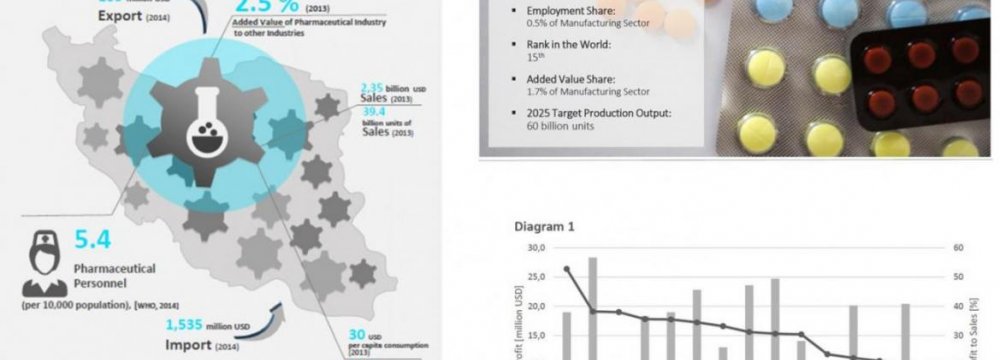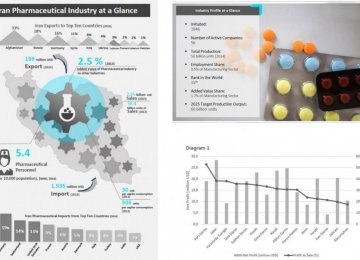The Iranian pharmaceutical market is predicted to be worth $3.31 billion in 2019, with a CAGR of 7.5%, from $2.35 billion in 2014, according to a white paper recently published by Tehran-based management consulting firm ILIA Corporation.
Below is the full text of the report:
In terms of medicine and medicaments, there are about 56 pharmaceutical companies in Iran, of which 36 are stock-listed companies that are producing more than 90% of the products.
Furthermore, there are 123 registered importers, 30 specialized distribution companies and 10,000 drugstores.
The industry can be divided into two main fields, namely production and import. 96% of the medicine are produced locally and only 4% are being imported. However, in terms of value, 55% of the market belong to local producers and 45% to the import market.
Key international players present in the Iranian market directly or indirectly include Novartis, Roche, Boehringer Ingelheim, Sanofi, Glaxo Smithkline and Novo Nordisk.
High medicine consumption rates among Iranians have been recorded with every citizen using approximately 340 units on average per year (almost one medicine unit each day). This makes Iran the second largest consumer per capita in Asia and the 20th in the world. The average number of medicine per prescription of doctors internationally is 2 units, whereas in Iran it is 3.5 units.
In 2014, more than $806 million worth of medical instruments were imported into Iran, while exports reached $23.6 million. Also, approximately $400-500 million worth of medical instruments are produced locally every year, especially for dentistry and laboratories.
Key governmental bodies responsible for the development of the pharmaceutical and medical equipment industries include Iran Food and Drug Organization and the Ministry of Industries.
In 2014, general policies for the country's healthcare sector were announced in the form of 14 articles, which focus on the creation and development of required infrastructures to produce pharmaceutical raw materials and products.
There are many successful stock-listed pharmaceutical companies in Iran, which are profitable. In Diagram No. 1, their net profit and profit ratio to sales amount are depicted.
Average ratio of benefit to sales of Iranian pharmaceutical companies in 2014 was approximately 31%. The highest ratio was achieved by Pars Darou with 52.8% and the lowest by Aburaihan with 17.4%.
➢ Main Barriers, Sanctions Impacts
Active companies describe the main barriers in the industry as high inflation rate, diminishing purchasing power and international sanctions. At the same time, they see opportunity with a growing Iranian population that requires health services.
No direct sanctions were imposed on the medical industry of Iran, however, since most of the international banks did not do transactions with the country anymore, the pharmaceutical industry was affected severely. Even cancer medicine became rare in Iran, leading to a black market with unreliable delivery and quality approval.
But nowadays after sanctions relief, international competition can be expected, as well as more investments. It is worth mentioning that the high demand of the neighboring countries for drugs and medical equipment is another opportunity for Iranian manufacturers and exporters.
The Iranian pharmaceutical market experienced a 30% increase in sales from 2009 to 2014, which is higher than the average in the region. The Middle East as a whole has experienced an 8.6% increase, while CIS countries experienced a 10.5% average increase rate from 2009 to 2014.
➢ Strengths
- Proper infrastructure in place (e.g. good quality factories)
- International experience in production of medicine
- Good quality of the end products
- Diverse product range
- Competent workforce
➢ Weaknesses
- Low efficiency rate of production throughout the industry
- Low capacity utilization rate in the industry
- Dependency on international market for producing key medicines
- The investment in R&D compared to international benchmarks is low
- Lagging behind technologically during sanctions time
➢ Opportunities
- Large domestic market
- Proximity to neighboring countries as new markets
- Potential to collaborate on joint projects with key international players
- Sanctions relief and better international conditions
- The new local healthcare system being a number one priority of the country
- Country's key performance indicators' improvement based on international reports
- Special attention of the government to healthcare and strategy of prevention
- Competitive price of local products
- Presence of Iran Food and Drug Organization as a centralized decision-making mechanism
- Private investment and the government supporting local production
➢ Threats
- Competitive and strict market in Iran
- Being dependent on the imports of raw materials
- The possibility of international players entering into the market
- High interest rate
- Difficulty of importing/transferring high technology to the local market
- The presence of the black/shadow market in Iran
- The presence of some internal conflicts in local distribution networks
- Increase in the number of drugstores (overcapacity in distribution network(
- Preference of consumers for international pharmaceutical brands
➢ Conclusion and Outlook
Considering Iran's strategic geopolitical positioning and access to extended neighboring marketplace of approximately 400 million that currently only have access to weak health systems, there is high potential for the industry and investors at large.
Concluding, the outlook for the years to come is positive for the Iranian pharmaceutical industry in general. Threats and barriers have to be taken into consideration carefully by local players and should be tackled smartly. International competition can be expected to increase substantially.
The original white paper can be accessed at http://www.ilia-corporation.com/wp-content/uploads/2015/06/Pharmaceutica....





